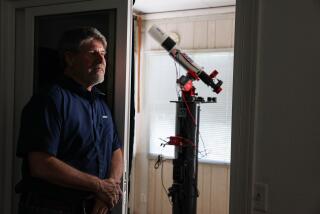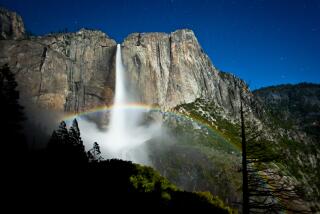They’re having a party, BYOT
FROM atop a stone amphitheater on Yosemite National Park’s Glacier Point, a pink glow envelops Half Dome and distant Sierra Nevada peaks as the sun sets.
It’s a beautiful scene, but the 20 or so amateur astronomers milling about didn’t haul their bulky telescopes way up here to look at granite.
The real show, the star party, begins when daylight yields and a billion sparkling lights spring from darkness.
People gather at star parties to gaze at obscure astral objects, talk about their scopes and, like their mentor cosmologist John Dobson, introduce the uninitiated to the cosmos.
It is a mission that Dobson began more than 50 years ago, and with or without him, is continued by his many disciples.
Morris “Mojo” Jones, a Monrovia computer programmer, mans a 14.5-inch-diameter Litebox Dobsonian. Named after the great man himself, the device looks like an artillery piece, and is a favorite among amateur stargazers.
The first spectacle takes form in the dark sky: Jupiter. Inside Jones’ telescope, the planet looks like a swirling, rust-colored marble. Io and Europa, two of the planet’s moons, shine like jewels.
The night grows dark and a thick, luminous mist arcs overhead. It’s the Milky Way, and the densest star cluster, the center of the galaxy, hovers over Vernal Fall.
Such displays are disappearing as light pollution from cities forces stargazers into national parks, remote deserts and secluded forests.
The brilliant night sky was once bare and obvious to the naked eye. It was the workplace where Copernicus, Edmund Halley and William Huggins -- amateurs of their day -- laid the foundations of modern astronomy.
Recently, amateurs equipped with super-accurate computerized telescopes and light-sensing devices have teamed with professional astronomers to discover asteroids, identify comets and stars, and investigate the breakup of the space shuttle Columbia. It is a partnership seldom seen in science.
Ron Bissinger, a Silicon Valley consulting finance officer who came to Glacier Point, helped professional astronomers in June detect the orbit of a planet 260 light years from Earth.
Jones and the others point their telescopes toward the southern sky for the next act in the cosmic drama: the lagoon nebulae, a cluster of stars that looks like tiny sugar crystals sprinkled on black velvet.
All night, the telescopes swing here and there, probing the Yosemite night sky, revealing the veil nebula, (a supernova remnant of billowing, glowing gas), Pluto (a blurry red dot) and the ring nebula (a glowing Cheerio).
Someone shouts, “What planet are you on?”
Jones cranks his telescope around in time to see Mars coming over the horizon. He got hooked on astronomy at a Glacier Point star party 12 years ago. Since then, he has attended about six events a year.
“I guess it makes your world bigger,” he says. “It makes God bigger.”







